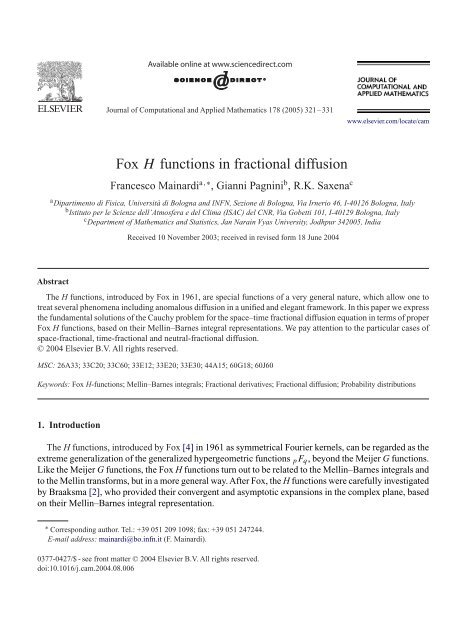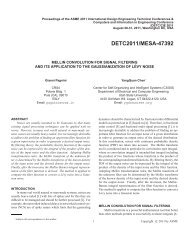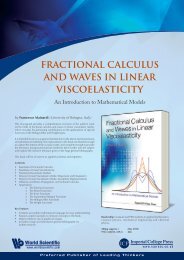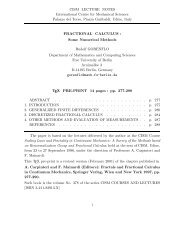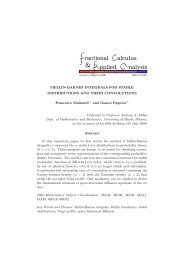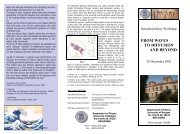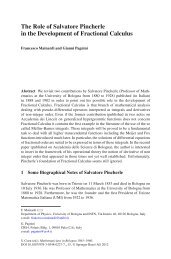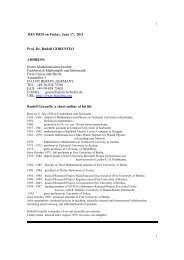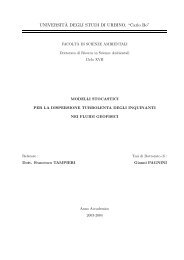Fox H functions in fractional diffusion - FRActional CALculus ...
Fox H functions in fractional diffusion - FRActional CALculus ...
Fox H functions in fractional diffusion - FRActional CALculus ...
Create successful ePaper yourself
Turn your PDF publications into a flip-book with our unique Google optimized e-Paper software.
Journal of Computational and Applied Mathematics 178 (2005) 321–331<br />
<strong>Fox</strong> H <strong>functions</strong> <strong>in</strong> <strong>fractional</strong> <strong>diffusion</strong><br />
Francesco Ma<strong>in</strong>ardi a,∗ , Gianni Pagn<strong>in</strong>i b , R.K. Saxena c<br />
www.elsevier.com/locate/cam<br />
a Dipartimento di Fisica, Università di Bologna and INFN, Sezione di Bologna, Via Irnerio 46, I-40126 Bologna, Italy<br />
b Istituto per le Scienze dell’Atmosfera e del Clima (ISAC) del CNR, Via Gobetti 101, I-40129 Bologna, Italy<br />
c Department of Mathematics and Statistics, Jan Nara<strong>in</strong> Vyas University, Jodhpur 342005, India<br />
Received 10 November 2003; received <strong>in</strong> revised form 18 June 2004<br />
Abstract<br />
The H <strong>functions</strong>, <strong>in</strong>troduced by <strong>Fox</strong> <strong>in</strong> 1961, are special <strong>functions</strong> of a very general nature, which allow one to<br />
treat several phenomena <strong>in</strong>clud<strong>in</strong>g anomalous <strong>diffusion</strong> <strong>in</strong> a unified and elegant framework.In this paper we express<br />
the fundamental solutions of the Cauchy problem for the space–time <strong>fractional</strong> <strong>diffusion</strong> equation <strong>in</strong> terms of proper<br />
<strong>Fox</strong> H <strong>functions</strong>, based on their Mell<strong>in</strong>–Barnes <strong>in</strong>tegral representations.We pay attention to the particular cases of<br />
space-<strong>fractional</strong>, time-<strong>fractional</strong> and neutral-<strong>fractional</strong> <strong>diffusion</strong>.<br />
© 2004 Elsevier B.V. All rights reserved.<br />
MSC: 26A33; 33C20; 33C60; 33E12; 33E20; 33E30; 44A15; 60G18; 60J60<br />
Keywords: <strong>Fox</strong> H-<strong>functions</strong>; Mell<strong>in</strong>–Barnes <strong>in</strong>tegrals; Fractional derivatives; Fractional <strong>diffusion</strong>; Probability distributions<br />
1. Introduction<br />
The H <strong>functions</strong>, <strong>in</strong>troduced by <strong>Fox</strong> [4] <strong>in</strong> 1961 as symmetrical Fourier kernels, can be regarded as the<br />
extreme generalization of the generalized hypergeometric <strong>functions</strong> pFq, beyond the Meijer G <strong>functions</strong>.<br />
Like the Meijer G <strong>functions</strong>, the <strong>Fox</strong> H <strong>functions</strong> turn out to be related to the Mell<strong>in</strong>–Barnes <strong>in</strong>tegrals and<br />
to the Mell<strong>in</strong> transforms, but <strong>in</strong> a more general way.After <strong>Fox</strong>, the H <strong>functions</strong> were carefully <strong>in</strong>vestigated<br />
by Braaksma [2], who provided their convergent and asymptotic expansions <strong>in</strong> the complex plane, based<br />
on their Mell<strong>in</strong>–Barnes <strong>in</strong>tegral representation.<br />
∗ Correspond<strong>in</strong>g author.Tel.: +39 051 209 1098; fax: +39 051 247244.<br />
E-mail address: ma<strong>in</strong>ardi@bo.<strong>in</strong>fn.it (F.Ma<strong>in</strong>ardi).<br />
0377-0427/$ - see front matter © 2004 Elsevier B.V. All rights reserved.<br />
doi:10.1016/j.cam.2004.08.006
322 F. Ma<strong>in</strong>ardi et al. / Journal of Computational and Applied Mathematics 178 (2005) 321–331<br />
More recently, the H <strong>functions</strong>, be<strong>in</strong>g related to the Mell<strong>in</strong> transforms, have been recognized to play<br />
a fundamental role <strong>in</strong> the probability theory and <strong>in</strong> <strong>fractional</strong> calculus as well as <strong>in</strong> their applications,<br />
<strong>in</strong>clud<strong>in</strong>g non-Gaussian stochastic processes and phenomena of nonstandard (i.e. anomalous) relaxation<br />
and <strong>diffusion</strong>, see e.g. [1,11–13,15,26–29,32–36].<br />
In section 2, we summarize the essential def<strong>in</strong>itions and notations for the <strong>Fox</strong> H <strong>functions</strong>.In section<br />
3, we <strong>in</strong>troduce the partial differential equation of <strong>fractional</strong> order (both <strong>in</strong> space and <strong>in</strong> time), that is<br />
<strong>in</strong>tended to generalize <strong>in</strong> a proper way the standard equation for normal <strong>diffusion</strong>.We also recall the<br />
ma<strong>in</strong> results of this generalized equation based on the Fourier–Laplace representation of its fundamental<br />
solution, the so-called Green function.Then, <strong>in</strong> section 4, we provide for the general Green function<br />
a representation <strong>in</strong> terms of Mell<strong>in</strong>–Barnes <strong>in</strong>tegrals and, consequently, <strong>in</strong> terms of <strong>Fox</strong> H <strong>functions</strong>.<br />
We then concentrate our attention to the particular but relevant cases of space <strong>fractional</strong>, time <strong>fractional</strong><br />
and neutral <strong>fractional</strong> <strong>diffusion</strong> for which the correspond<strong>in</strong>g Green <strong>functions</strong> are clearly <strong>in</strong>terpreted as<br />
probability densities.Further properties regard<strong>in</strong>g the Green function <strong>in</strong> the general cases of space–time<br />
<strong>fractional</strong> <strong>diffusion</strong> can be extracted from the analysis conta<strong>in</strong>ed <strong>in</strong> [21] where, however, the passage<br />
from the Mell<strong>in</strong>–Barnes <strong>in</strong>tegrals to the correspond<strong>in</strong>g H-<strong>functions</strong> is not treated.<br />
2. The <strong>Fox</strong> H <strong>functions</strong><br />
Accord<strong>in</strong>g to a standard notation, the <strong>Fox</strong> H function is def<strong>in</strong>ed as<br />
H m,n<br />
<br />
1<br />
p,q (z) = H<br />
2i L<br />
m,n<br />
p,q (s) zs ds, (2.1)<br />
where L is a suitable path <strong>in</strong> the complex plane C to be disposed later, zs = exp{s(log |z|+iargz)},<br />
and<br />
H m,n<br />
p,q<br />
A(s) =<br />
C(s) =<br />
A(s) B(s)<br />
(s) = , (2.2)<br />
C(s)D(s)<br />
m<br />
j=1<br />
q<br />
j=m+1<br />
(bj − j s), B(s) =<br />
n<br />
(1 − aj + j s), (2.3)<br />
j=1<br />
(1 − bj + j s), D(s) =<br />
p<br />
j=n+1<br />
(aj − j s) (2.4)<br />
with 0np ,1mq , {aj ,bj }∈C , {j , j }∈R + . An empty product, when it occurs, is taken to<br />
be one so<br />
n = 0 ⇐⇒ B(s) = 1, m= q ⇐⇒ C(s) = 1, n= p ⇐⇒ D(s) = 1.<br />
Due to the occurrence of the factor zs <strong>in</strong> the <strong>in</strong>tegrand of (2.1), the H function is, <strong>in</strong> general, multi-valued,<br />
but it can be made one-valued on the Riemann surface of log z by choos<strong>in</strong>g a proper branch.We also<br />
note that when the ’s and ’s are equal to 1, we obta<strong>in</strong> the Meijer’s G-<strong>functions</strong> G m,n<br />
p,q (z).
F. Ma<strong>in</strong>ardi et al. / Journal of Computational and Applied Mathematics 178 (2005) 321–331 323<br />
The above <strong>in</strong>tegral representation of the H <strong>functions</strong>, by <strong>in</strong>volv<strong>in</strong>g products and ratios of Gamma<br />
<strong>functions</strong>, is known to be of Mell<strong>in</strong>–Barnes <strong>in</strong>tegral type. 1 A compact notation is usually adopted for<br />
(2.1):<br />
H m,n<br />
<br />
<br />
<br />
m,n (aj<br />
, j ) j=1,...,,p<br />
p,q (z) = Hp,q z <br />
.<br />
<br />
(2.5)<br />
(bj , j ) j=1,...,q<br />
Thus, the s<strong>in</strong>gular po<strong>in</strong>ts of the kernel H are the poles of the Gamma <strong>functions</strong> enter<strong>in</strong>g the expressions of<br />
A(s) and B(s), that we assume do not co<strong>in</strong>cide.Denot<strong>in</strong>g by P(A) and P(B), the sets of these poles, we<br />
write P(A) ∩ P(B) =∅. The conditions for the existence of the H-<strong>functions</strong> can be made by <strong>in</strong>spect<strong>in</strong>g<br />
the convergence of <strong>in</strong>tegral (2.1), which can depend on the selection of the contour L and on certa<strong>in</strong><br />
relations between the parameters {ai, i} (i = 1,...,p) and {bj , j } (j = 1,...,q).For the analysis of<br />
the general case we refer to the specialized treatises on H <strong>functions</strong>, e.g. [27,28,35] and, <strong>in</strong> particular to<br />
the paper by Braaksma [2], where an exhaustive discussion on the asymptotic expansions and analytical<br />
cont<strong>in</strong>uation of these <strong>functions</strong> is found; see also [12].<br />
In the follow<strong>in</strong>g we limit ourselves to recall the essential properties of the H <strong>functions</strong> preferr<strong>in</strong>g to later<br />
analyse <strong>in</strong> detail those <strong>functions</strong> related to <strong>fractional</strong> <strong>diffusion</strong>.As it will be shown later, this phenomenon<br />
depends on one real <strong>in</strong>dependent variable and three parameters; <strong>in</strong> this case we shall have z = x ∈ R and<br />
m2, n2, p 3, q 3.<br />
The contour L <strong>in</strong> (2.1) can be chosen as follows:<br />
(i) L = L−i∞,+i∞ chosen <strong>in</strong> a manner to go from −i∞ to +i∞ leav<strong>in</strong>g to the right all the poles of<br />
P(A), namely the poles sj,k =(bj +k)/j ; j =1, 2,...,m; k =0, 1,...of the <strong>functions</strong> enter<strong>in</strong>g A(s),<br />
and to left all the poles of P(B), namely the poles sj,l = (aj − 1 − l)/j ; j = 1, 2,...,n; l = 0, 1,...<br />
of the <strong>functions</strong> enter<strong>in</strong>g B(s).<br />
(ii) L = L+∞ is a loop beg<strong>in</strong>n<strong>in</strong>g and end<strong>in</strong>g at +∞ and encircl<strong>in</strong>g once <strong>in</strong> the negative direction all<br />
the poles of P(A), but none of the poles of P(B).<br />
(iii) L = L−∞ is a loop beg<strong>in</strong>n<strong>in</strong>g and end<strong>in</strong>g at −∞ and encircl<strong>in</strong>g once <strong>in</strong> the positive direction all<br />
the poles of P(B), but none of the poles of P(A).<br />
Braaksma has shown that, <strong>in</strong>dependently of the choice of L the Mell<strong>in</strong>–Barnes <strong>in</strong>tegral makes sense<br />
and def<strong>in</strong>es an analytic function of z <strong>in</strong> the follow<strong>in</strong>g two cases:<br />
q p<br />
> 0, 0 < |z| < ∞, where = j − j , (2.6)<br />
= 0, 0 < |z| < , where =<br />
(bj , j ) 1,q<br />
j=1<br />
p<br />
j=1<br />
−j<br />
j<br />
j=1<br />
q<br />
j=1<br />
j j . (2.7)<br />
On account of the follow<strong>in</strong>g useful and important formula for the H-function<br />
H m,n<br />
<br />
<br />
(aj<br />
, j ) 1,p<br />
p,q z <br />
= H<br />
<br />
n,m<br />
<br />
<br />
1 <br />
<br />
(1 − bj , j ) 1,q<br />
q,p<br />
z <br />
, (2.8)<br />
(1 − aj , j ) 1,p<br />
1 As a historical note, we po<strong>in</strong>t out that the names refer to the two authors, who <strong>in</strong> the first 1910s developed the theory of<br />
these <strong>in</strong>tegrals us<strong>in</strong>g them for a complete <strong>in</strong>tegration of the hypergeometric differential equation.However, these <strong>in</strong>tegrals were<br />
first used <strong>in</strong> 1888 by P<strong>in</strong>cherle, see e.g. [23].Recent treatises on Mell<strong>in</strong>–Barnes <strong>in</strong>tegrals are those <strong>in</strong> [25,30].
324 F. Ma<strong>in</strong>ardi et al. / Journal of Computational and Applied Mathematics 178 (2005) 321–331<br />
we can transform the H-function with < 0 and argument z to one with > 0 and argument 1/z.This<br />
property is suitable to compare the results of the theory of H <strong>functions</strong> based on (2.1) with zs with the<br />
other one with z−s , often used <strong>in</strong> the literature.<br />
Other important properties of the <strong>Fox</strong> H <strong>functions</strong>, that can be easily derived from their def<strong>in</strong>ition, are<br />
<strong>in</strong>cluded <strong>in</strong> the list below:<br />
(i) The H-function is symmetric <strong>in</strong> the set of pairs<br />
(a1, 1),...,(an, n), (an+1, n+1),...,(ap, p),<br />
(b1, 1),...,(bm, m) and (bm+1, m+1),...,(bq, q). (ii) If one of the (aj , j ), j = 1,...,n,is equal to one of the (bj , j ), j = m + 1,...,q; [or one of<br />
the pairs (aj , j ), j = n + 1,...,p is equal to one of the (bj , j ), j = 1,...,m], then the H-function<br />
reduces to one of the lower order, that is, p, q and n [or m] decrease by a unity.Provided n1 and q>m,<br />
we have<br />
H m,n<br />
<br />
<br />
<br />
(aj , j ) 1,p<br />
p,q z <br />
= H<br />
(bj<br />
, j ) 1,q−1 (a1, 1)<br />
m,n−1<br />
<br />
<br />
<br />
(aj , j ) 2,p<br />
p−1,q−1 z <br />
, (2.9)<br />
(bj<br />
, j ) 1,q−1<br />
H m,n<br />
<br />
<br />
<br />
(aj<br />
, j ) 1,p−1 (b1, <br />
p,q z<br />
1)<br />
<br />
= H<br />
(b1, 1)(bj , j ) 2,q<br />
m−1,n<br />
<br />
<br />
<br />
(aj<br />
, j ) 1,p−1<br />
p−1,q−1 z <br />
. (2.10)<br />
(bj , j ) 2,q<br />
(iii)<br />
z H m,n<br />
<br />
<br />
(aj<br />
, j ) 1,p<br />
p,q z <br />
= H<br />
(bj<br />
, j ) 1,q<br />
m,n<br />
<br />
<br />
<br />
(aj + j , j ) 1,p<br />
p,q z <br />
. (2.11)<br />
(bj<br />
+ j , j ) 1,q<br />
(iv)<br />
<br />
1<br />
<br />
m,n (aj<br />
, j ) 1,p<br />
Hp,q z <br />
= H<br />
c (bj<br />
, j ) 1,q<br />
m,n<br />
<br />
p,q z c<br />
<br />
<br />
<br />
(aj<br />
,cj ) 1,p<br />
<br />
, c>0. (2.12)<br />
(bj<br />
,cj ) 1,q<br />
The convergent and asymptotic expansions (for z → 0orz →∞) are mostly obta<strong>in</strong>ed by apply<strong>in</strong>g<br />
the residue theorem <strong>in</strong> the poles (assumed to be simple) of the Gamma <strong>functions</strong> enter<strong>in</strong>g A(s) or B(s)<br />
that are found <strong>in</strong>side the specially chosen path.In some cases (<strong>in</strong> particular if n = 0 ⇐⇒ B(s) = 1) we<br />
f<strong>in</strong>d an exponential asymptotic behaviour.<br />
In the presence of a multiple pole s0 of order N the treatment becomes more cumbersome because we<br />
need to expand <strong>in</strong> power series at the pole the product of the <strong>in</strong>volved <strong>functions</strong>, <strong>in</strong>clud<strong>in</strong>g zs , and to take<br />
the first N terms up to (s − s0) N−1 <strong>in</strong>clusive.Then the coefficient of (s − s0) N−1 is the required residue.<br />
Let us consider the case N = 2 (double pole) of <strong>in</strong>terest for the <strong>fractional</strong> <strong>diffusion</strong>.Then, the expansions<br />
for the Gamma <strong>functions</strong> are of the type<br />
(s) = (s0) [1 + (s0)(s − s0) + O((s − s0) 2 )], s → s0, s0 = 0, −1, −2,...,<br />
(−1)<br />
(s) =<br />
k<br />
(k + 1)(s + k)] [1 + (k + 1)(s + k) + O((s + k)2 )], s →−k,<br />
where k = 0, 1, 2,...and (z) denotes the logarithmic derivative of the function,<br />
(z) = d<br />
dz log (z) = ′ (z)<br />
(z) ,
F. Ma<strong>in</strong>ardi et al. / Journal of Computational and Applied Mathematics 178 (2005) 321–331 325<br />
whereas the expansion of z s yields the logarithmic term<br />
z s = z s0 [1 + log z(s − s0) + O((s − s0) 2 ], s → s0.<br />
3. The <strong>fractional</strong> <strong>diffusion</strong> equation<br />
An <strong>in</strong>terest<strong>in</strong>g way to generalize the classical <strong>diffusion</strong> equation<br />
2<br />
<br />
u(x, t) = u(x, t), −∞
326 F. Ma<strong>in</strong>ardi et al. / Journal of Computational and Applied Mathematics 178 (2005) 321–331<br />
For = 0 we have a symmetric operator with respect to x, that can be <strong>in</strong>terpreted as<br />
xD 0 =−<br />
<br />
− d2<br />
dx2 /2<br />
. (3.6)<br />
This can be formally deduced by writ<strong>in</strong>g −|| =−( 2 ) /2 . For 0 < < 2 and || m<strong>in</strong> {, 2 − }, the<br />
Riesz–Feller derivative can be shown to admit the <strong>in</strong>tegral representation <strong>in</strong> the x doma<strong>in</strong>,<br />
xD <br />
<br />
(1 + )<br />
∞ f(x + ) − f(x)<br />
f(x) = s<strong>in</strong> [( + )/2]<br />
<br />
0 1+<br />
d<br />
∞<br />
<br />
+ s<strong>in</strong>[( − )/2]<br />
d . (3.7)<br />
0<br />
f(x − ) − f(x)<br />
1+<br />
By denot<strong>in</strong>g the Laplace transform of a sufficiently well-behaved (generalized) function f(t), f(s) =<br />
L {f(t); s}= ∞<br />
0 e −st f(t) dt,R(s)>af , the Caputo time-<strong>fractional</strong> derivative of order (m−1 < m,<br />
m ∈ N) turns out to be def<strong>in</strong>ed through<br />
L{ tD ∗ f(t); s}=s m−1 <br />
f(s) −<br />
k=0<br />
s −1−k f (k) (0 + ), m − 1 < m. (3.8)<br />
This leads to def<strong>in</strong>e, see e.g. [7,31],<br />
tD ⎧<br />
⎪⎨<br />
1 t f<br />
∗ f(t) := (m − ) 0<br />
⎪⎩<br />
(m) () d<br />
,<br />
+1−m (t − )<br />
d<br />
m−1 <
F. Ma<strong>in</strong>ardi et al. / Journal of Computational and Applied Mathematics 178 (2005) 321–331 327<br />
so that<br />
<br />
G , (,s)=<br />
s−1 s + ().<br />
(3.12)<br />
By us<strong>in</strong>g the known scal<strong>in</strong>g rules for the Fourier and Laplace transforms, we <strong>in</strong>fer without <strong>in</strong>vert<strong>in</strong>g the<br />
two transforms,<br />
G , (x, t) = t−K <br />
, (x/t ), = /, (3.13)<br />
where the one-variable function K <br />
, is the reduced Green function and x/t is the similarity variable.<br />
We note from G, (0,s)= 1/s ⇐⇒ G , (0,t)= 1, the normalization property<br />
+∞<br />
−∞<br />
G , (x, t) dx =<br />
+∞<br />
−∞<br />
and, from () = (−) = − (−), the symmetry relation<br />
K ,<br />
K <br />
, (x) dx = 1, (3.14)<br />
(−x) = K−(x),<br />
(3.15)<br />
,<br />
which allows us to restrict our attention to x>0.<br />
When = 2( = 0) and = 1 the <strong>in</strong>version of the Fourier–Laplace transform <strong>in</strong> (3.12) is trivial: we<br />
recover the Gaussian density, evolv<strong>in</strong>g <strong>in</strong> time with variance 2 = 2t, typical of the normal <strong>diffusion</strong>,<br />
G 0 1<br />
2,1 (x, t) =<br />
2 √ t exp(−x2 /(4t)), x ∈ R, t >0, (3.16)<br />
which exhibits the similarity law (3.13) with = 1 2 .<br />
4. Mell<strong>in</strong>–Barnes and <strong>Fox</strong> H representations of the Green function<br />
Ma<strong>in</strong>ardi et al. [21] have <strong>in</strong>verted the Fourier–Laplace transform (3.12) of the Green function by<br />
pass<strong>in</strong>g through the Mell<strong>in</strong> transform.Here we recall and complement their ma<strong>in</strong> results by <strong>in</strong>troduc<strong>in</strong>g<br />
the representation of the reduced Green function <strong>in</strong> terms of proper <strong>Fox</strong> H <strong>functions</strong>, start<strong>in</strong>g from its<br />
general Mell<strong>in</strong>–Barnes <strong>in</strong>tegral representation for x>0,<br />
K 1 1<br />
, (x) =<br />
x 2i<br />
+i∞<br />
−i∞<br />
(s/)(1 − s/)(1 − s)<br />
([( − )/2]s)(1 −[( − )/2]s)(1 − (/)s) xs ds, (4.1)<br />
with 0 < < m<strong>in</strong>(, 1) under the condition ||2 − .<br />
From the Mell<strong>in</strong>–Barnes representation (4.1) we now derive the representation of K , (x) <strong>in</strong> terms of<br />
a proper H function, tak<strong>in</strong>g <strong>in</strong>to account the theory of <strong>Fox</strong> <strong>functions</strong> briefly summarized <strong>in</strong> Section 2.<br />
At first we dist<strong>in</strong>guish the two cases (a) < and (b) > for which the correspond<strong>in</strong>g H <strong>functions</strong><br />
turn out to be s<strong>in</strong>gular <strong>in</strong> x = 0 and ∞, respectively.Tak<strong>in</strong>g x>0, we get<br />
K <br />
<br />
1 1,2 1<br />
<br />
(0,<br />
, (x) = H3,3 <br />
x x <br />
1 −<br />
)(0, 1)(0, 2 )<br />
<br />
, < , (4.2a)<br />
(0, 1 <br />
−<br />
)(0, )(0, 2 )
328 F. Ma<strong>in</strong>ardi et al. / Journal of Computational and Applied Mathematics 178 (2005) 321–331<br />
K <br />
<br />
, (x) =<br />
1 2,1<br />
H3,3 x<br />
x<br />
<br />
<br />
<br />
<br />
<br />
(1, 1 −<br />
)(1, )(1, 2 )<br />
(1, 1 −<br />
)(1, 1)(1, 2 )<br />
, > . (4.2b)<br />
When = the correspond<strong>in</strong>g H function is s<strong>in</strong>gular <strong>in</strong> z = x = 1. However, the s<strong>in</strong>gularity is removable<br />
because, surpris<strong>in</strong>gly, the correspond<strong>in</strong>g (reduced) Green function can be expressed (<strong>in</strong> explicit form) <strong>in</strong><br />
terms of a (nonnegative) elementary function, that we denote by N (x), as it is shown <strong>in</strong> [21].We refer<br />
to this case as to neutral-<strong>fractional</strong> <strong>diffusion</strong> and the correspond<strong>in</strong>g representation through H <strong>functions</strong><br />
is redundant.Explicitly we write, for x>0,<br />
Neutral <strong>diffusion</strong> :0< = < 2; m<strong>in</strong>{, 2 − },<br />
K , := N 1 x<br />
(x) =<br />
<br />
−1 s<strong>in</strong>[(/2)( − )]<br />
1 + 2x . (4.3)<br />
cos[(/2)( − )]+x2 As far as we know, this case of <strong>fractional</strong> <strong>diffusion</strong> seems not so well treated <strong>in</strong> the literature.We note that<br />
N (x) may be considered the <strong>fractional</strong> generalization (with skewness) of the well-known (symmetric)<br />
Cauchy density.<br />
For the other particular cases outl<strong>in</strong>ed <strong>in</strong> Section 3 we have to properly use properties (2.9)–(2.11) <strong>in</strong><br />
general expressions (4.2a)–(4.2b) <strong>in</strong> order to obta<strong>in</strong> the correspond<strong>in</strong>g representations <strong>in</strong> terms of simpler<br />
<strong>Fox</strong> H <strong>functions</strong>.<br />
Normal <strong>diffusion</strong> : = 2, = 1; = 0.<br />
The case of normal (or standard) <strong>diffusion</strong> is known to be characterized by the Gaussian probability<br />
density function.Indeed the reduced Green function reads<br />
<br />
K 0 1<br />
2,1 (x) := D(x) =<br />
2 √ exp(−x2 /4), x ∈ R, (4.4)<br />
so, for x>0, we have<br />
D(x) = 1 1<br />
2x 2i<br />
+i∞<br />
−i∞<br />
(1 − s)<br />
(1 − s/2) xs ds = 1<br />
<br />
1,0<br />
H1,1 x<br />
2<br />
<br />
<br />
(<br />
<br />
<br />
1 2 , 1 2 )<br />
<br />
. (4.5)<br />
(0, 1)<br />
Space-<strong>fractional</strong> <strong>diffusion</strong>:0< < 2, = 1;|| m<strong>in</strong>{, 2 − }.<br />
In this case the reduced Green function K ,1 (x) is known to be the -strictly stable Lévy density that<br />
(x).Then, for x>0, we have<br />
we denote by L <br />
+i∞<br />
K ,1 (x) := L 1 1<br />
(x) =<br />
x 2i −i∞<br />
(s/)(1 − s)<br />
([( − )/2]s)(1 −[(− )/2]s) xs ds (4.6)<br />
with 0 < < m<strong>in</strong>(, 1), Then, by dist<strong>in</strong>guish<strong>in</strong>g the two cases as <strong>in</strong> Eqs.(4.2), we obta<strong>in</strong>:<br />
(a) 0 < < 1;||,<br />
L <br />
1 1,1 1<br />
<br />
(1, 1)(<br />
(x) = H2,2 <br />
x <br />
− −<br />
2 , 2 )<br />
<br />
. (4.7a)<br />
(b) 1 < < 2;||2 − ,<br />
<br />
<br />
<br />
x <br />
<br />
L 1 1,1<br />
(x) = H2,2 <br />
( 1 , 1 )(−<br />
2<br />
, −<br />
2 )<br />
(1 − 1 , 1 <br />
(0, 1)(1 − −<br />
2<br />
− −<br />
)(1 − 2 , 2 )<br />
, −<br />
2 )<br />
<br />
. (4.7b)
F. Ma<strong>in</strong>ardi et al. / Journal of Computational and Applied Mathematics 178 (2005) 321–331 329<br />
We note that it was Schneider [33], who first <strong>in</strong> 1986 has recognized that all stable probability densities<br />
can be represented <strong>in</strong> terms of <strong>Fox</strong> H <strong>functions</strong>.<br />
Previously, the stable (non-Gaussian) densities were known <strong>in</strong> general through their (convergent and<br />
asymptotic) series representations that <strong>in</strong> a few particular cases, { = 1 −1<br />
3 , = 3 }, { = 1 −1<br />
2 , = 2 },<br />
{ = 2 3 , = 0}, { = 3 2 , = 1 2 }, were <strong>in</strong>terpreted <strong>in</strong> terms of known special <strong>functions</strong>.In his remarkable<br />
(but almost entirely neglected) article, Schneider has also po<strong>in</strong>ted out the errors present <strong>in</strong> the literature<br />
for some of the above particular cases.<br />
More recently, the representation of the stable densities through Mell<strong>in</strong>–Barnes <strong>in</strong>tegrals has been<br />
exhaustively treated by a number of authors as <strong>in</strong> [36,21].<br />
Time-<strong>fractional</strong> <strong>diffusion</strong> : = 2, 0 < < 2; = 0.<br />
In this case the reduced Green function K ,1 (x) is known to be a probability density with stretched<br />
exponential tails, that we denote (for historical reasons) by 1 2 M/2 where M/2 denotes a Wright-type<br />
function. 4 We thus write<br />
K 0 2, (x) := 1 2 M/2(x), (4.8)<br />
where, for x>0,<br />
M/2(x) = 1<br />
x<br />
<br />
1 +i∞<br />
2i −i∞<br />
(1 − s)<br />
(1 − s/2) x s ds = H 1,0<br />
<br />
1,1 x<br />
<br />
<br />
<br />
<br />
<br />
(1 − <br />
2 , 2 )<br />
<br />
(0, 1)<br />
with 0 < < 1.<br />
As a check we note that the simpler H function <strong>in</strong> (4.5) for the Gaussian density is recovered from<br />
(4.7a) <strong>in</strong> the limit = 2 and from (4.8)–(4.9) <strong>in</strong> the limit = 1.<br />
4 The function M(z) is def<strong>in</strong>ed for any order ∈ (0, 1) and ∀z ∈ C by<br />
M(z) =<br />
∞<br />
n=0<br />
(−z) n 1<br />
=<br />
n![−n + (1 − )] <br />
∞<br />
n=1<br />
(−z) n−1<br />
(n) s<strong>in</strong>(n).<br />
(n − 1)!<br />
It turns out that M(z) is an entire function of order = 1/(1 − ), which provides a generalization of the Gaussian and of the<br />
Airy function.In fact, we obta<strong>in</strong><br />
M1/2(z) = 1<br />
√ exp(− z<br />
2 /4), M1/3(z) = 3 2/3 Ai(z/3 1/3 ).<br />
M(z) is a special case of the Wright function ,(z).Orig<strong>in</strong>ally, Wright [37–39] <strong>in</strong>troduced and <strong>in</strong>vestigated the function<br />
,(z) :=<br />
∞<br />
n=0<br />
zn , 0, z ∈ C,<br />
n!(n + )<br />
with the restriction 0, <strong>in</strong> a series of notes start<strong>in</strong>g from 1933 <strong>in</strong> the framework of the asymptotic theory of partitions.Only<br />
later, <strong>in</strong> 1940, he [40] considered the case −1 < < 0. We note that <strong>in</strong> the handbook of the Bateman Project, see [3], Vol.3, Ch.<br />
18, presumably for a mispr<strong>in</strong>t, is restricted to be nonnegative.In his first analysis of the time <strong>fractional</strong> <strong>diffusion</strong> equation,<br />
Ma<strong>in</strong>ardi [17], aware of the Bateman project but not of the 1940 paper by Wright, <strong>in</strong>troduced the two (Wright-type) auxiliary<br />
<strong>functions</strong>, F(z) := −,0(−z) and M(z) := −,1−(−z) with 0 < < 1, <strong>in</strong>ter-related through F(z) = zM(z). For detailed<br />
<strong>in</strong>formation on the Wright-type <strong>functions</strong> (possibly related to time-<strong>fractional</strong> <strong>diffusion</strong> equations), the <strong>in</strong>terested reader may<br />
consult e.g. [18–20,5,6,10,14].<br />
(4.9)
330 F. Ma<strong>in</strong>ardi et al. / Journal of Computational and Applied Mathematics 178 (2005) 321–331<br />
5. Conclusions<br />
As a conclusive remark we po<strong>in</strong>t out that the nonnegativity of the above <strong>functions</strong>, obta<strong>in</strong>ed <strong>in</strong> the<br />
particular cases of neutral, space and time <strong>fractional</strong> <strong>diffusion</strong>, are relevant <strong>in</strong> prov<strong>in</strong>g that, <strong>in</strong> the general<br />
case of space–time <strong>fractional</strong> <strong>diffusion</strong>, the Green <strong>functions</strong> are still spatial probability densities evolv<strong>in</strong>g<br />
<strong>in</strong> time, provided that 0 < 2 with 0 < 1 and 12, see [21].The proof is based on the<br />
convolution theorem for the Mell<strong>in</strong> transforms and provides <strong>in</strong>terest<strong>in</strong>g subord<strong>in</strong>ation formulas, see [24].<br />
This fact could also be shown by us<strong>in</strong>g the properties of the <strong>Fox</strong> H <strong>functions</strong>.<br />
Acknowledgements<br />
The authors are grateful to the anonymous referees for useful comments and suggestions.Research<br />
performed under the auspices of the National Group of Mathematical Physics (G.N.F.M.—I.N.D.A.M.)<br />
of Italy. FM acknowledges partial support by the Italian M<strong>in</strong>istry of University (M.I.U.R) and by the<br />
National Institute of Nuclear Physics (INFN).<br />
References<br />
[1] V.V.Anh, N.N.Leonenko, Spectral analysis of <strong>fractional</strong> k<strong>in</strong>etic equations with random data, J.Statist.Phys.104 (2001)<br />
1349–1387.<br />
[2] B.L.J. Braaksma, Asymptotic expansions and analytical cont<strong>in</strong>uations for a class of Barnes-<strong>in</strong>tegrals, Compositio Math.<br />
15 (1962–1963) 239–341.<br />
[3] A.Erdélyi, W.Magnus, F.Oberhett<strong>in</strong>ger, F.G.Tricomi, Higher Transcendental Functions, vol.1, McGraw-Hill, NewYork,<br />
1953.<br />
[4] C.<strong>Fox</strong>, The G and H <strong>functions</strong> as symmetrical Fourier kernels, Trans.Amer.Math.Soc.98 (1961) 395–429.<br />
[5] R.Gorenflo,Yu.Luchko, F.Ma<strong>in</strong>ardi, Analytical properties and applications of the Wright function, Fract.Cal.Appl.Anal.<br />
2 (1999) 383–414.<br />
[6] R.Gorenflo, Yu.Luchko, F.Ma<strong>in</strong>ardi, Wright <strong>functions</strong> as scale-<strong>in</strong>variant solutions of the <strong>diffusion</strong>-wave equation, J.<br />
Comput.Appl.Math.118 (2000) 175–191.<br />
[7] R.Gorenflo, F.Ma<strong>in</strong>ardi, Fractional calculus: <strong>in</strong>tegral and differential equations of <strong>fractional</strong> order, <strong>in</strong>: A.Carp<strong>in</strong>teri, F.<br />
Ma<strong>in</strong>ardi (Eds.), Fractals and Fractional Calculus <strong>in</strong> Cont<strong>in</strong>uum Mechanics, Spr<strong>in</strong>ger, Wien, 1997, pp. 223–276 (repr<strong>in</strong>ted<br />
with revisions <strong>in</strong> http://www.fracalmo.org).<br />
[8] R.Gorenflo, F.Ma<strong>in</strong>ardi, Random walk models for space-<strong>fractional</strong> <strong>diffusion</strong> processes, Fract.Cal.Appl.Anal.1 (2)<br />
(1998) 167–191.<br />
[9] R.Gorenflo, F.Ma<strong>in</strong>ardi, D.Moretti, G.Pagn<strong>in</strong>i, P.Paradisi, Discrete random walk models for space–time <strong>fractional</strong><br />
<strong>diffusion</strong>, Chem.Phys.284 (2002) 521–541.<br />
[10] R.Gorenflo, F.Ma<strong>in</strong>ardi, H.M.Srivastava, Special <strong>functions</strong> <strong>in</strong> <strong>fractional</strong> relaxation-oscillation and <strong>fractional</strong> <strong>diffusion</strong>wave<br />
phenomena, <strong>in</strong>: D.Ba<strong>in</strong>ov (Ed.), Proceed<strong>in</strong>gs VIII International Colloquium on Differential Equations, Plovdiv 1997,<br />
VSP International Science Publ., Utrecht, 1998, pp. 195–202.<br />
[11] R.Hilfer, Fractional time evolution, <strong>in</strong>: R.Hilfer (Ed.), Applications of Fractional Calculus <strong>in</strong> Physics, World Scientific,<br />
S<strong>in</strong>gapore, 2000, pp.87–130.<br />
[12] A.A.Kilbas, M.Saigo, On the H <strong>functions</strong>, J.Appl.Math.Stochastic Anal.12 (1999) 191–204.<br />
[13] A.A.Kilbas, M.Saigo, H-transforms.Theory and Applications, CRC Press, Boca Raton, FL, 2004.<br />
[14] A.A Kilbas, M.Saigo, J.J.Trujillo, On the generalized Wright function, Fract.Cal.Appl.Anal.5 (2002) 437–460.<br />
[15] V.Kiryakova, Generalized Fractional Calculus and Applications, Pitman Research Notes <strong>in</strong> Mathematics, vol.301,<br />
Longman, Harlow, 1994.<br />
[16] A.N.Kochubei, Fractional order <strong>diffusion</strong>, J.Differential Equations 26 (1990) 485–492.
F. Ma<strong>in</strong>ardi et al. / Journal of Computational and Applied Mathematics 178 (2005) 321–331 331<br />
[17] F.Ma<strong>in</strong>ardi, On the <strong>in</strong>itial value problem for the <strong>fractional</strong> <strong>diffusion</strong>-wave equation, <strong>in</strong>: S.Rionero, T.Ruggeri (Eds.),<br />
Waves and Stability <strong>in</strong> Cont<strong>in</strong>uous Media, World Scientific, S<strong>in</strong>gapore, 1994, pp.246–251.<br />
[18] F.Ma<strong>in</strong>ardi, The fundamental solutions for the <strong>fractional</strong> <strong>diffusion</strong>-wave equation, Appl.Math.Lett.9 (6) (1996) 23–28.<br />
[19] F.Ma<strong>in</strong>ardi, Fractional relaxation-oscillation and <strong>fractional</strong> <strong>diffusion</strong>-wave phenomena, Chaos, Soliton.Fract.7 (1996)<br />
1461–1477.<br />
[20] F.Ma<strong>in</strong>ardi, Fractional calculus: some basic problems <strong>in</strong> cont<strong>in</strong>uum and statistical mechanics, <strong>in</strong>:A.Carp<strong>in</strong>teri, F.Ma<strong>in</strong>ardi<br />
(Eds.), Fractals and Fractional Calculus <strong>in</strong> Cont<strong>in</strong>uum Mechanics, Spr<strong>in</strong>ger, Wien and New York, 1997, pp. 248–291<br />
(repr<strong>in</strong>ted <strong>in</strong> http://www.fracalmo.org).<br />
[21] F.Ma<strong>in</strong>ardi, Yu.Luchko, G.Pagn<strong>in</strong>i, The fundamental solution of the space–time <strong>fractional</strong> <strong>diffusion</strong> equation, Fract.Cal.<br />
Appl.Anal.4 (2) (2001) 153–192 (repr<strong>in</strong>ted <strong>in</strong> http://www.fracalmo.org).<br />
[22] F.Ma<strong>in</strong>ardi, G.Pagn<strong>in</strong>i, The Wright <strong>functions</strong> as solutions of the time-<strong>fractional</strong> <strong>diffusion</strong> equations, Appl.Math.Comput.<br />
141 (2003) 51–62.<br />
[23] F.Ma<strong>in</strong>ardi, G.Pagn<strong>in</strong>i, Salvatore P<strong>in</strong>cherle: the pioneer of the Mell<strong>in</strong>–Barnes <strong>in</strong>tegrals, J.Comput.Appl.Math.153<br />
(2003) 331–342.<br />
[24] F.Ma<strong>in</strong>ardi, G.Pagn<strong>in</strong>i, R.Gorenflo, Mell<strong>in</strong> transform and subord<strong>in</strong>ation laws <strong>in</strong> <strong>fractional</strong> <strong>diffusion</strong> processes, Fract.<br />
Cal.Appl.Anal.6 (2003) 441–459.<br />
[25] O.I. Marichev, Handbook of Integral Transforms of Higher Transcendental Functions, Theory and Algorithmic Tables,<br />
Ellis Horwood, Chichester, 1983.<br />
[26] A.M. Mathai, A few remarks on the exact distributions of certa<strong>in</strong> multivariate statics; II, <strong>in</strong>: D.G. Kabe, R.P. Gupta (Eds.),<br />
Multivariate Statistical Inference, North-Holland, Amsterdam, 1973, pp.169–181.<br />
[27] A.M. Mathai, R.K. Saxena, Generalized Hypergeometric Functions with Applications <strong>in</strong> Statistics and Physical Sciences,<br />
Lecture Notes <strong>in</strong> Mathematics, vol.348, Spr<strong>in</strong>ger, Berl<strong>in</strong>, 1973.<br />
[28] A.M. Mathai, R.K. Saxena, The H-function with Applications <strong>in</strong> Statistics and Other Discipl<strong>in</strong>es, Wiley Eastern Ltd., New<br />
Delhi, 1978.<br />
[29] R.Metzler, J.Klafter, The random walk’s guide to anomalous <strong>diffusion</strong>: a <strong>fractional</strong> dynamics approach, Phys.Rep.339<br />
(2000) 1–77.<br />
[30] R.B.Paris, D.Kam<strong>in</strong>ski, Asymptotic and Mell<strong>in</strong>–Barnes Integrals, Cambridge University Press, Cambridge, 2001.<br />
[31] I.Podlubny, Fractional Differential Equations, Academic Press, San Diego, 1999.<br />
[32] R.K. Saxena, T.F. Nonnenmacher, Application of the H-function <strong>in</strong> Markovian and non-Markovian cha<strong>in</strong> models, Fract.<br />
Cal.Appl.Anal.7 (2004) 135–148.<br />
[33] W.R.Schneider, Stable distributions: <strong>Fox</strong> function representation and generalization, <strong>in</strong>: S.Albeverio, G.Casati, D.Merl<strong>in</strong>i<br />
(Eds.), Stochastic Processes <strong>in</strong> Classical and Quantum Systems, Lecture Notes <strong>in</strong> Physics, vol. 262, Spr<strong>in</strong>ger, Berl<strong>in</strong>, 1986,<br />
pp.497–511.<br />
[34] W.R.Schneider, W.Wyss, Fractional <strong>diffusion</strong> and wave equations, J.Math.Phys.30 (1989) 134–144.<br />
[35] H.M. Srivastava, K.C. Gupta, S.P. Goyal, The H-Functions of One and Two Variables with Applications, South Asian<br />
Publishers, New Delhi, 1982.<br />
[36] V.V.Uchaik<strong>in</strong>, V.M.Zolotarev, Chance and Stability.Stable Distributions and their Applications, VSP, Utrecht, 1999.<br />
[37] E.M.Wright, On the coefficients of power series hav<strong>in</strong>g exponential s<strong>in</strong>gularities, J.London Math.Soc.8 (1933) 71–79.<br />
[38] E.M.Wright, The asymptotic expansion of the generalized Bessel function, Proc.London Math.Soc.(Ser.II) 38 (1935)<br />
257–270.<br />
[39] E.M.Wright, The asymptotic expansion of the generalized hypergeometric function, J.London Math.Soc.10 (1935)<br />
287–293.<br />
[40] E.M.Wright, The generalized Bessel function of order greater than one, Quart.J.Math., Oxford Ser.11 (1940) 36–48.


